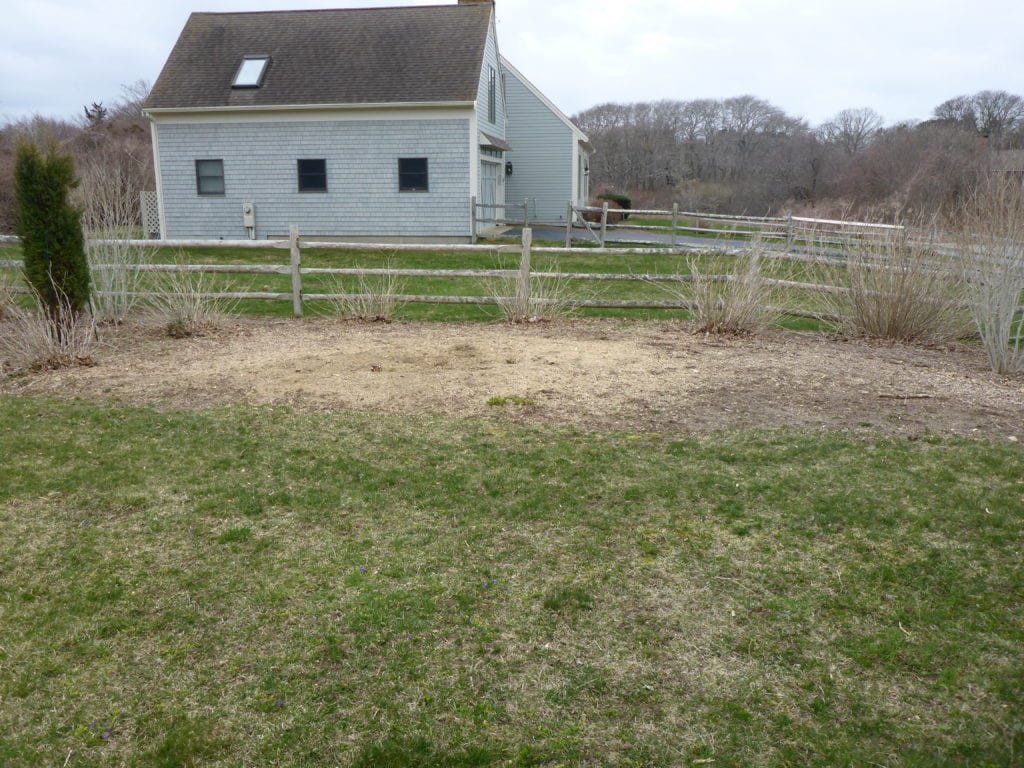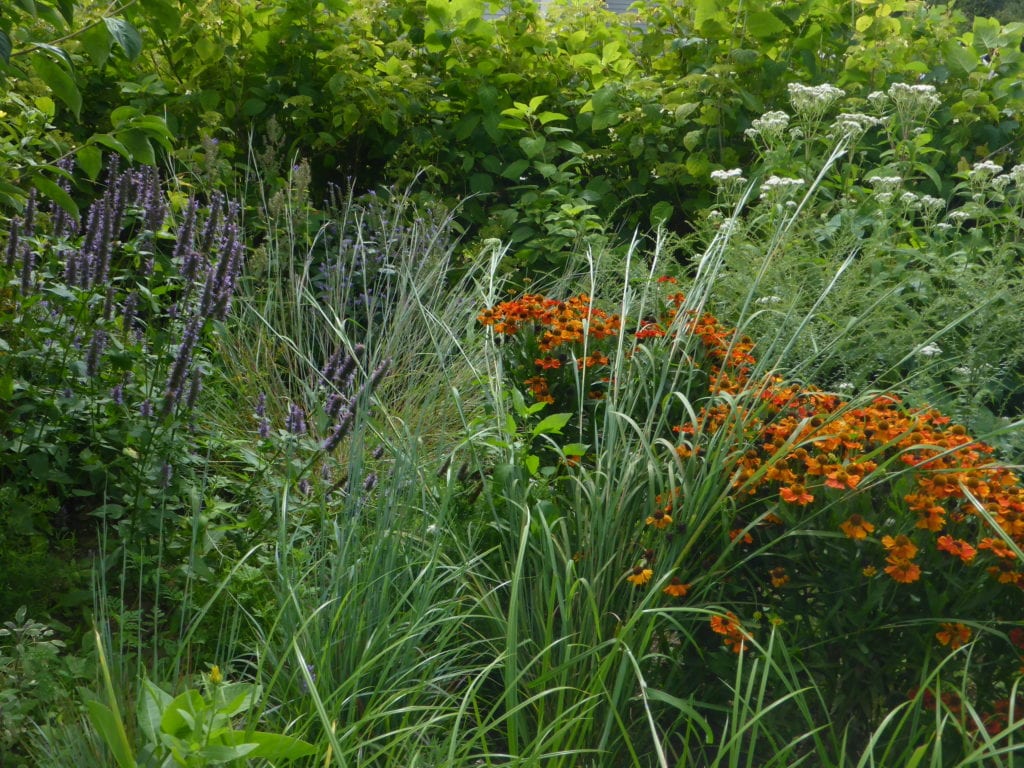By Cathy Weston
I’m a home gardener, and this is the story of a long-term project to restore my Cape Cod property to an eco-friendly habitat. I felt it important, as a good citizen, to do my part to help the environment in three ways: by accelerating the property’s reversion to a woodland, re-landscaping using native plants, and supporting the needs of local wildlife.
The property is old farmland on two acres in Chatham, MA, about a mile from the ocean. The open half-acre in front includes the house, vegetable garden, ornamental beds, and a Cape Cod lawn (no fertilizer, watering, or pesticides). The back 1.5 acres, which was fallow for 40 years, was covered in rough turf, volunteer trees and shrubs, and invasives.
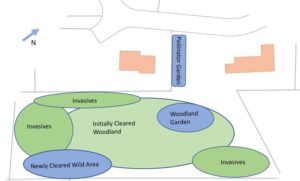
Diagram of the projects.
Getting Started
Five years ago, my first goal was simply to get rid of the invasives.
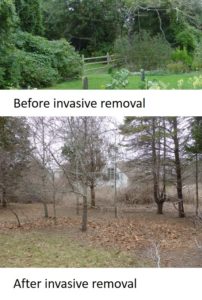
Looking south into a wall of invasives; Bottom: Looking west into the same area, now cleared.
I engaged professionals to start clearing Japanese honeysuckle, bittersweet, Russian olive, and porcelain berry. They cleared about half of it that first season, cutting everything to the ground and swiping with herbicides. When they were done, there was a large space with young oaks, black cherries, red cedars, non-native spruces, and no herbaceous layer.
Keeping the invasives from returning was my job, which involved regular cutbacks of new growth and one more round of cut-and-swipe the next year. Five years later, I still perform occasional cutbacks especially of the bittersweet and porcelain berry, but it is much less of a chore.
First Inspiration
The first planting project I tackled was a woodland garden in the shady area under red cedars, black cherries, and spruce. I strove for something lovely and textured, inspired by the overall look of Garden in the Woods. The structure came from a 60-foot pathway, with the area around it cleared of grasses and weeds and enriched with compost. I then installed a wide range of woodland plants including inkberry, low-bush blueberry, lady fern, hairgrass, blue wood asters, wild columbine, and black cohosh. Then I watched, tended, learned, and adjusted.
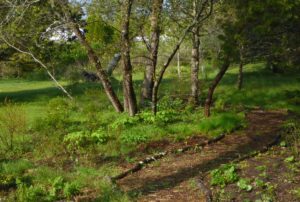
A low herbaceous layer of inkberry, sweet fern, bugbane, blue wood asters, and hairgrass under a clump of black cherry and spruce.
Many plants did well – wild strawberry, black cohosh, lady fern – but others failed – low-bush blueberry, phlox, Virginia bluebells. I learned that native plants can be tricky to establish, and to try out a few plants for a year or two before making a big investment, to really understand what would do well on the site.
Site Analysis
Before thinking about planting on a larger scale, I needed to conduct a deeper site analysis. I ordered a soil analysis, mapped sun/shade areas and prevailing winds, and identified microclimates. I found the site has typical Cape Cod soil: acidic (pH between 5 and 6) and well-drained sandy loam. The wind is an issue all year, especially storms with gale winds that bring salt from the ocean. The weather is rainy and cool from November to May and warm, humid, and droughty from June to October. Whatever I planted needed to be tough.
Trees and Structure
The next year it was time to address the canopy layer for the woodland, with the idea of helping Nature along rather than creating a designed woodland. Using an inventory of the native woody plants already growing as volunteers – arrowwood, bayberry, winged sumac, red cedar, black cherry, white and black oaks – I studied native habitats and woodland succession and determined that I had an Old Field habitat that was evolving to a Coastal Woodland. The woodland was in a transition stage that featured early-stage sumac, black cherry, and red cedar, but also included several later-stage oak trees.
To accelerate the succession, I needed to plant additional oak trees plus red maples and white pine for diversity. After siting the trees strategically to expand the wooded area, I hired a tree company to install them. Regular irrigation and a bit of supplemental organic matter have helped them settle in nicely.
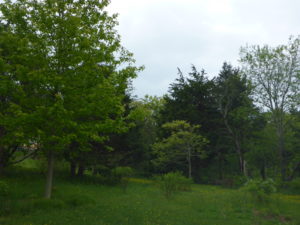
Looking South at the woodland edge, from left: planted red maple, young black oak in front of red cedar, spruce snag, black cherries, and the woodland garden, and silky dogwood, winterberry, and sweet pepperbush in front
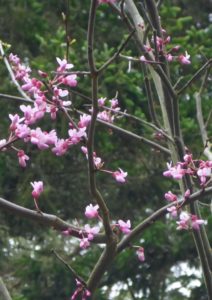
Redbud blooming in front of the spruce tree.
Since that initial planting, I have continued the woodland expansion by adding redbud and witch hazel as understory trees and a variety of shrubs at the edges, including rhododendron, sweet fern, clethra, silky dogwood, and winterberry. Another oak tree has emerged, and I can see that an interesting canopy layer is developing.
Pollinator Beds
- After removing a sycamore maple, an open sunny space edged with smooth hydrangeas along the fence.
- From left: A garden of anise hyssop, little bluestem, sneezeweed, boneset in front of smooth hydrangea.
More recently I focused on the 80’ x 20’ sunny border along one edge of the property. From an ecological perspective, my goals were to create a multi-layer plant community for local pollinators. From a design perspective, I was aiming for a naturalistic style and arranging plants for balanced shapes, eye movement, and focal points. Researching plant lists and playing with different ways of combining them to satisfy both ecological and design goals, made a great winter project. The sunny border is now a dense planting of shrubs, grasses, and herbaceous perennials, all selected as “powerhouse” plants, and pollinators abound.
Each year I have replaced failed plants with new species and rearranged successful plants for a more pleasing design. The highlights have been the smooth hydrangea, prairie dropseed, anise hyssop, spotted beebalm, boneset, wild indigo, mountain mint, and swamp milkweed. Not so successful, was everything the rabbits enjoy, such as black-eyed Susan, coneflower, and allium.
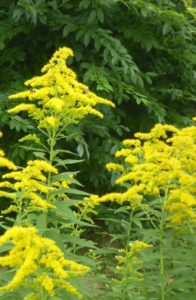
Canada goldenrod in front of the privet hedge.
It wouldn’t be a Cape Cod garden without goldenrod. Solidago canadensis is a volunteer on the property, coming up everywhere. I edit it to select locations and then enjoy a brilliant golden show in late summer and fall that attracts all sorts of pollinators. I am also experimenting with different varieties of goldenrod – Solidago nemoralis, S. rugosa ‘Fireworks’, S. odora, and S. caesia. These plants help with an “old farm” aesthetic while supporting wildlife.
Circling Back to Invasives
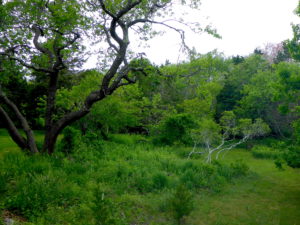
The newly cleared area with black cherry, bayberry, arrowwood viburnum, pagoda dogwood in the rear, and Canada goldenrod and young red cedar in the front.
Last year was the second phase of invasive removal, with professionals clearing the farthest back corner of the property using a cut and swipe approach. The clearing revealed mature black cherries, swamp oak, pagoda dogwood, bayberries, and high-bush blueberry.
The site is sunny and moist, and it will remain wild. My only work is having the wide rough turf paths mowed and cutting back returning invasives. So far, goldenrod has come in, the bayberry and blueberry are colonizing, wild strawberry has spread, and two more oak trees have emerged. Natural succession is occurring right in front of me.
Continuous Expansion
There are years’ worth of projects left to do. There are more large patches of invasives to remove and re-plant before the property is mostly invasive-free. In several places, non-native trees have come down in storms, so I am taking advantage of re-planting opportunities there. The non-native cottage garden is gradually being replanted with native pollinators. And I am continuing to fill in the understory of the woodland.
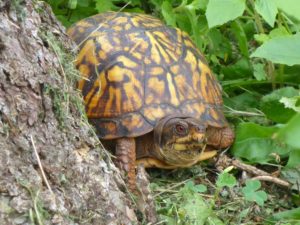
A visiting Eastern box turtle.
How true is the saying that a garden is never complete? But there is a certain satisfaction that comes with taking better care of my piece of the landscape. Chickadees are nesting, a box turtle visits, hawks and coyotes look for the voles and rabbits – Happily, nature is returning!
About the Author

Cathy Weston in her garden.
After a business career and a lifetime of traditional gardening, Cathy embarked on a journey to become a garden ecologist and native-plant landscape designer. She completed a Certificate in Native Plant Horticulture and Design from the New England Wild Flower Society and she writes a blog www.goldenrodgarden.com about using native plants in her Cape Cod garden.
In addition to her own gardening, she volunteers with the horticulture staff at the Rose Kennedy Greenway Conservancy in Boston as a regular zone gardener and as a horticultural writer. She is a Trustee at the Chatham Conservation Foundation, the land trust serving Chatham MA, and serves on the Board of the Friends of Sylvan Gardens, a conservation area in Chatham MA

